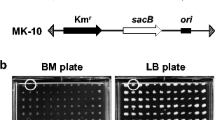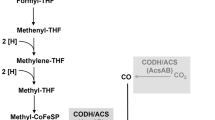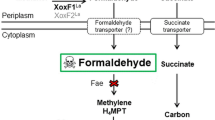Abstract
Acetamide, a nitrogen and carbon source for Chlamydomonas reinhardtii, is hydrolyzed by acetamidase to ammonium and acetate. It also induces urea pathway activities. Fluoroacetamide (F-acetamide) is toxic to wild-type through conversion to F-citrate, a respiratory inhibitor. Resistant mutants were selected on plates of F-acetamide plus urea. When tested on acetamide plates two mutant classes were obtained, acm+ (utilized acetamide as sole N source) and acm-. All acm+ isolates had acetamidase activity and were obligate phototrophs (i.e. “dark-diers”). Acm- isolates had either normal urea assimilation (ure+) or lacked all urea pathway activities, namely transport, urea carboxylase and allophanate hydrolase (ure-). Inheritance patterns for both types indicated single nuclear gene mutations. The acm- ure+ type presumably resulted from a defective acetamidase gene, and the acm- ure- strains might be regulatory gene mutants. Temperature conditional F-acetamide tolerant mutants were also obtained. Acetamidase extracted from one such strain was more thermolabile than the wild-type enzyme, indicating a mutation in the coding region. The hypothesis that acetamidase is involved in urea assimilation was not supported by the genetic and biochemical evidence.
Similar content being viewed by others
Abbreviations
- F-acetamide:
-
fluoroacetamide
- F-acetate:
-
fluoroacetate
- TAP:
-
tris-acetate-phosphate medium
- CDB:
-
Chlamydomonas dilution buffer
- TCA:
-
trichloroacetic acid
- AH:
-
allophanate hydrolase
- UC:
-
urea carboxylase
- PAR:
-
photosynthetically active radiation
- DCMU:
-
3-(3,4-dichlorophenyl)-1,1-dimethylurea
References
Draper P (1967) The aliphatic acrylamide amidohydrolase of Mycobacterium smegmatis: its inducible nature and relation to acyl transfer to hydroxylamine. J Gen Microbiol 46:111–123
Galloway RE, Goodenough UW (1985) Genetic analysis of mating locus linked mutations in Chlamydomonas reinhardii. Genetics 111:447–461
Gresshoff PM (1976) Culture of Chlamydomonas reinhardi protoplasts in defined media. Aust J Plant Physiol 3:457–464
Gresshoff PM (1981a) Amide metabolism of Chlamydomonas reinhardi. Archiv Microbiol 128:303–306
Gresshoff PM (1981b) Induction and repression of acetamidase in Chlamydomonas reinhardi. Aust J Plant Physiol 8:525–533
Harris E (1984) Chlamydomonas reinhardtii. In: O'Brien SJ (ed) Genetic maps, vol 3. Cold Spring Harbor, New York, pp 216–223
Hodson RC, Gresshoff PM (1979) Survey of acetamidase-less Chlamydomonas strains for defective urea and arginine assimilation. Plant Physiol 63 (Suppl): 47
Hodson RC, Williams SK II, Davidson WR Jr (1975) Metabolic control of urea catabolism in Chlamydomonas reinhardi and Chlorella pyrenoidosa. J Bacteriol 121:1022–1035
Hynes M (1975) Amide utilization in Aspergillus nidulans: Evidence for a third amidase enzyme. J Gen Microbiol 91:99–109
Hynes M, Pateman J (1970) The use of amides as nitrogen sources by Aspergillus nidulans. J Gen Microbiol 63:317–324
Kelly JM, Hynes MJ (1985) Transformation of Aspergillus niger by the amdS gene of Aspergillus nidulans. EMBO J 4:475–479
Kelly M, Clarke PH (1962) An inducible amidase produced by a strain of Pseudomonas aeruginosa. J Gen Microbiol 27:305–316
Levine RP, Ebersold WT (1960) The genetics and cytology of Chlamydomonas. Ann Rev Microbiol 14:197–216
Muftic MK (1964) A new phenol-hypochlorite reaction for ammonia. Nature (Lond) 201:622–623
Orth GM, Tolbert NE, Jimenez E (1966) Rate of glycolate formation during photosynthesis at high pH. Plant Physiol 41:143–147
Tilburn J, Scazzochio C, Taylor GG, Zabicky-Zissman JH, Lockington RA, Davies RW (1983) Transformation by integration in Aspergillus nidulans. Gene 26:205–221
Van Winkle-Swift K (1977) Maturation of algal zygotes: Alternative experimental approaches for Chlamydomonas reinhardtii. J Physiol 13:225–231
Whitney PA, Cooper T (1972) Urea carboxylase and allophanate hydrolase. Two components of adenosine triphosphate: urea amido-lyase in Saccharomyces cerevisiae. J Biol Chem 247:1349–1353
Williams SK II, Hodson RC (1977) Transport of urea at low concentrations in Chlamydomonas reinhardi. J Bacteriol 130:266–273
Wiseman A, Gillham NW, Boynton JE (1977) Nuclear mutants affecting mitochondrial structure and function in Chlamydomonas. J Cell Biol 73:56–77
Author information
Authors and Affiliations
Rights and permissions
About this article
Cite this article
Hodson, R.C., Gresshoff, P.M. Fluoroacetamide resistance mutations in Chlamydomonas reinhardtii . Arch. Microbiol. 148, 8–13 (1987). https://doi.org/10.1007/BF00429639
Received:
Accepted:
Issue Date:
DOI: https://doi.org/10.1007/BF00429639




